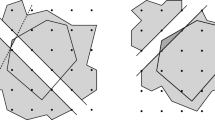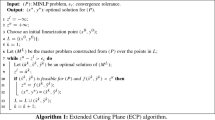Abstract
Sparse cutting-planes are often the ones used in mixed-integer programing (MIP) solvers, since they help in solving the linear programs encountered during branch-&-bound more efficiently. However, how well can we approximate the integer hull by just using sparse cutting-planes? In order to understand this question better, given a polyope P (e.g. the integer hull of a MIP), let P k be its best approximation using cuts with at most k non-zero coefficients. We consider d(P, P k) = \(\max_{x \in{\bf P}^k} (\min_{y \in \bf P} \| x - y\|)\) as a measure of the quality of sparse cuts.
In our first result, we present general upper bounds on d(P, P k) which depend on the number of vertices in the polytope and exhibits three phases as k increases. Our bounds imply that if P has polynomially many vertices, using half sparsity already approximates it very well. Second, we present a lower bound on d(P, P k) for random polytopes that show that the upper bounds are quite tight. Third, we show that for a class of hard packing IPs, sparse cutting-planes do not approximate the integer hull well. Finally, we show that using sparse cutting-planes in extended formulations is at least as good as using them in the original polyhedron, and give an example where the former is actually much better.
Santanu S. Dey and Qianyi Wang were partially supported by NSF grant CMMI-1149400.
Access this chapter
Tax calculation will be finalised at checkout
Purchases are for personal use only
Preview
Unable to display preview. Download preview PDF.
Similar content being viewed by others
References
Achterberg, T.: Personal communication
Andersen, K., Weismantel, R.: Zero-coefficient cuts. In: Eisenbrand, F., Shepherd, F.B. (eds.) IPCO 2010. LNCS, vol. 6080, pp. 57–70. Springer, Heidelberg (2010)
Boyd, S., Vandenberghe, L.: Convex Optimization. Cambridge University Press (2004)
Gu, Z.: Personal communication
Kaparis, K., Letchford, A.N.: Separation algorithms for 0-1 knapsack polytopes. Mathematical Programming 124(1-2), 69–91 (2010)
Koltchinskii, V.: Oracle Inequalities in Empirical Risk Minimization and Sparse Recovery Problems. Springer (2011)
Narisetty, A.: Personal communication
Ziegler, G.M.: Lectures on Polytopes. Springer (1995)
Author information
Authors and Affiliations
Editor information
Editors and Affiliations
Rights and permissions
Copyright information
© 2014 Springer International Publishing Switzerland
About this paper
Cite this paper
Dey, S.S., Molinaro, M., Wang, Q. (2014). How Good Are Sparse Cutting-Planes?. In: Lee, J., Vygen, J. (eds) Integer Programming and Combinatorial Optimization. IPCO 2014. Lecture Notes in Computer Science, vol 8494. Springer, Cham. https://doi.org/10.1007/978-3-319-07557-0_22
Download citation
DOI: https://doi.org/10.1007/978-3-319-07557-0_22
Publisher Name: Springer, Cham
Print ISBN: 978-3-319-07556-3
Online ISBN: 978-3-319-07557-0
eBook Packages: Computer ScienceComputer Science (R0)




